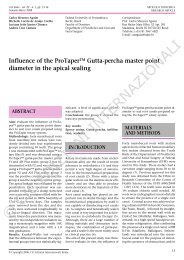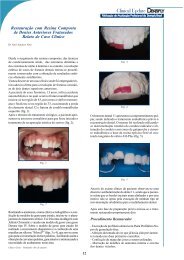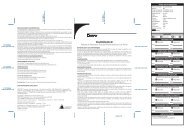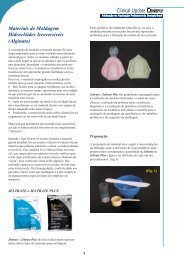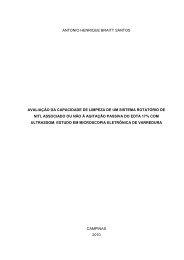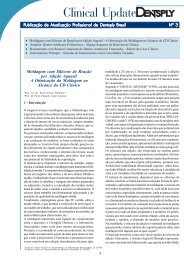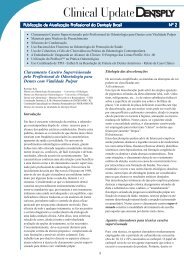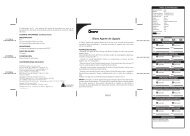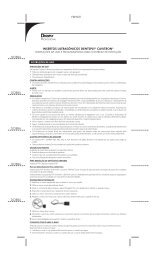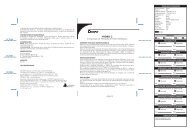You also want an ePaper? Increase the reach of your titles
YUMPU automatically turns print PDFs into web optimized ePapers that Google loves.
Ferrari et al<br />
Table 1 Changes in pre- and postoperative sensitivities (1 = lowest, 10 = highest<br />
sensitivity)<br />
case<br />
XP Bond / SCA / Calibra [n]<br />
Type of Pre- Postoperative Postoperative<br />
restoration operative sensitivity sensitivity<br />
sensitivity (2 weeks (6 months<br />
after<br />
after<br />
placement)<br />
placement)<br />
1 Inlay (OD) 0 6 3<br />
2 Inlay (MOD) 0 1 0<br />
3 Inlay (MO) 0 1 0<br />
4 2 onlays 2 0 0<br />
5 Onlay 0 1 0<br />
6 Inlay (MOD) 3 1 0<br />
and onlay<br />
7 Inlay (MO) 0 1 0<br />
8 Onlay 4 1 0<br />
9 Onlay 0 3 2<br />
10 Inlay (MOD) 0 1 0<br />
11 Inlay (MOD) 0 3 2<br />
tial or full restoration was performed from the pool of patients<br />
accessing the department of Restorative Dentistry of<br />
the University of Siena. Patients’ written consent to the trial<br />
was obtained after having provided a complete explanation<br />
of the aim of the study.<br />
Inclusion and Exclusion Criteria<br />
Males and females aged 18 to 60 years in good general and<br />
periodontal health were included. Patients to whom the following<br />
factors applied were excluded from the clinical trial:<br />
1. Under 18 years of age<br />
2. Pregnancy<br />
3. Disabilities<br />
4. Prosthodontic restoration of tooth can be expected<br />
5. Pulpitic, nonvital, or endodontically treated teeth<br />
6. (Profound, chronic) periodontitis<br />
7. Deep defects (< 1 mm from pulp) or pulp capping<br />
8. Heavy occlusal contacts or history of bruxism<br />
9. Systemic disease or severe medical complications<br />
10. History of allergy to methacrylates<br />
11. Rampant caries<br />
12. Xerostomia<br />
13. Lack of compliance<br />
14. Language barriers<br />
Test Stimuli and Assessment<br />
Before applying the adhesive material, a pain measurement<br />
was performed utilizing a simple pain scale based on the response<br />
method. Response was determined to a 1-s application<br />
of air from a dental unit syringe (at 40 to 65 psi at approximately<br />
20°C), directed perpendicularly to the root surface<br />
at a distance of 2 cm, and by tactile stimuli with a sharp<br />
#5 explorer. The patient was asked to rate the perception of<br />
the sensitivity experienced during this thermal/tactile stimulation<br />
by placing a mark on a visual analog scale (VAS) beginning<br />
at 0 and ending at 10 (where 0 = no pain and 10 =<br />
excruciating pain). In order to translate these scores into<br />
easily understood pain levels, a score of 0 was defined as<br />
no pain, 1 to 4 as mild sensitivity (which was provoked by the<br />
air blast), and 5 to 10 as strong sensitivity (which was spontaneously<br />
reported by the patient during drinking and eating).<br />
Only patients scoring low on the VAS were included in<br />
the study, whereas high score cases were excluded based<br />
on the assumption that irreversible pulp inflammation could<br />
be sustaining the high sensitivity. The status of the gingival<br />
tissues adjacent to the test sites was observed at baseline<br />
and at each recall. Patients were recalled to our department<br />
for testing postoperative sensitivity after 2 weeks and 6<br />
months.<br />
Clinical Procedure<br />
For standardization purposes, the same operator performed<br />
all the clinical procedures. Following anesthesia, the rubberdam<br />
was placed, all carious structures were excavated, and<br />
any restorative material was removed. Preparation was performed<br />
using conventional diamond burs in a high-speed<br />
handpiece with no bevel on margins. The preparation design<br />
was dictated by the extent of decay and pre-existing restorations.<br />
The residual dentin thickness (RDT) was evaluated on<br />
a periapical radiograph, and teeth with RDT thinner than 0.5<br />
mm were excluded. After preparation, the impression of the<br />
prepared tooth was taken and sent to the laboratory. A temporary<br />
restoration was performed. One week later, the ceramic<br />
restorations were luted. Luting procedures were performed<br />
under rubbes-dam. The cavity preparation was<br />
cleaned with a rotating brush and pumice, and then water<br />
280 The Journal of Adhesive Dentistry



